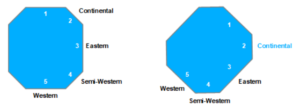Learn tennis volley
In 5 steps to the perfect tennis volley for beginners
In 5 steps to the perfect tennis volley for beginners
A volley in tennis is usually played at the front of the net. The tennis ball does not bounce but is played directly out of the air. Building on strong forehand and backhand strokes, there is often an opportunity to get to the net and win the point with a volley.
Volleys are played one-handed with the strong hand on the forehand as well as on the backhand side, i.e. with the right hand for right-handers and with the left hand for left-handers. Especially in doubles, a well played volley usually decides about victory or defeat.
Below we explain to tennis beginners the 5 steps to the perfect tennis volley: from the volley grip, the backswing, the movement and the outswing to volley tips.
1. Tennis volley grip
At the net you have to react much faster than at the baseline, where you have more time to prepare for the next groundstroke. Therefore, you should quickly internalize the correct forehand and backhand volley grip.
Due to the average distance of 1.5 meters to the net, the so-called Continental grip is ideal for forehand and backhand volley. The Continental grip allows a quick change to both sides, because it is no longer necessary to change the grip.
The volleys are usually not hit but pressed more, so that the tennis ball is played with little spin.

2. Tennis volley backswing
You are on your way to the net and you hold the tennis racket in front of you in the middle to be able to react quickly.
You are in T-line and your opponent hits the ball. You do a split step – a two-legged jump on your toes – and see the tennis ball coming towards you.
For the forehand volley, turn your upper body to the forehand side and take the tennis racket in a natural motion. It is important not to swing the tennis racket backwards, because you simply don’t have the time.
As a right-handed player, your upper body is facing the net with your left shoulder while your racket is held parallel to the net. Your knees are clearly bent and your weight is stable on your back foot.
For the backhand volley, turn your upper body to the backhand side and take the tennis racket with you in a natural movement. It is also important here that the tennis racket is not extended backwards.
Inverted, as a right-handed player, your upper body faces the net with your right shoulder while your racket is held parallel to the net. Your knees are also clearly bent and your weight is stable on the back foot.
3. Tennis volley movement
To perfect the volley motion, extend your forearm forward toward the tennis ball when hitting it. The arm is as fully extended as possible on the forehand and backhand side.
You shift your weight from your back foot to your front foot and hit the tennis ball clearly in front of your body. The tennis racket is sideways in front of you when you hit the ball.
4. Tennis volley outswing
For the outswing of the volley, the natural movement sequence is simply continued: you turn your upper body back to the center, take the 2nd hand again to the racket grip and go back to the center of the court or starting position.
Notice again that outswing without outswing, motion sequence and outswing is one fluid motion.
5. Typical tennis volley mistakes and tips
Finally, three typical mistakes and tips to improve your volley:
a) Don’t retrieve the racket
The most common mistake made by tennis beginners is that the tennis racket is also retrieved backwards at the net and therefore the ball is hit much too late and not in front of the body. For good volleys, it also depends on your reaction speed. Therefore, do not lunge the racket but push the balls into the court.
b) Go deep into the knees
For the preparation of the volley you should go deeper into the knees compared to the preparation for the forehand or backhand. This will allow you to push off from the split-step with more energy in one direction, increasing your reach at the net. This is because you usually don’t have time for extra steps to get yourself into position.
c) Play a backhand volley in front of your body
If your opponent aims the tennis ball directly at your body, play a backhand volley. The backhand volley reflects the natural movement and enables a comparatively easy volley to the forehand. Likewise, a potential forehand volley simply lacks the time to get into the right position.


